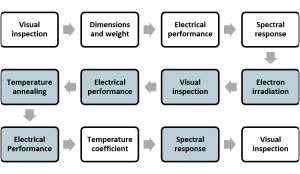TFQD goal is to bring new knowledge and strong innovation into the space and terrestrial energy production field, by integrating novel concepts and non-standard, interdisciplinary Key Enabling Technologies such as advanced materials, photonics, and advanced manufacturing processes.
Being the primary power source in spacecraft systems, solar array impose tight constraints to conceive and realize novel satellite designs, which should be more versatile and efficient to meet the needs of future space applications. The high-efficiency and lightweight of the TFQD device allows for the development of flexible and compact solar arrays with significant mass and space saving, with substantial impact on the performance of future telecommunication and scientific satellites, deep space exploration, space stations.
Major advantages of the solar cell developed in TFQD such as high power-to-weight and power-to-cost ratios will also make it as a viable breakthrough technology in Concentrating Photovoltaics for clean and renewable energy production. A further important field of terrestrial exploitation is high-end consumer electronics devices. Finally lighter and more compact solar arrays enabled by TFQD will allow to increase the performance of telecommunication satellites.
To maximize the impact of project results, research and technology development activities to demonstrate the TFQD solar cell concept, are complemented by a significant effort into exploitation oriented activities such as space oriented testing and validation and pre-industrialization assessment led by the industrial partners.

